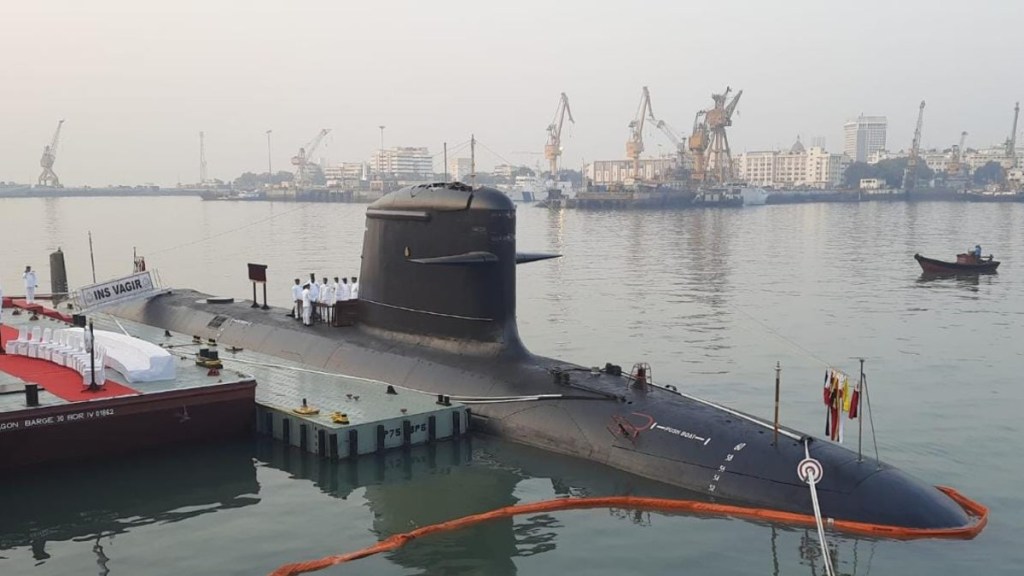On Monday the fifth diesel-electric Kalvari class submarine `Vagir’ was commissioned in the Indian Navy and enhancing its combat potential and firepower and capabilities.
Keeping in line with Indian Navy’s old tradition that ‘old ships & submarines never die, this new submarine is the reincarnation of the erstwhile Vagir, which had served the country and the Navy for three decades.
Speaking during the ceremony the Indian Navy Chief Admiral R Hari Kumar said that Vagir gets its name from the ‘Sand shark’ which is a deep sea predator of the Indian Ocean. And, true to the name, in its new avatar Vagir too is a lethal platform and it now comes with a formidable weapon package and state-of-the-art stealth technology.
According to the Navy Chief this was the third submarine to be inducted into the Navy in a short span of 24 months. “This underscores the coming of age of India’s shipbuilding industry, and the maturing of our defence ecosystem.” Adding that by 2047 the Indian Navy will be fully self-reliant `Atmanirbhar force’.
More about the Vagir
It is among the six submarines under Project 75 which have been built at the Mumbai based Mazagon Dock Shipbuilders Limited (MDL), and is in collaboration with the French M/s Naval Group. As reported in Financial Express Online earlier the navy has already commissioned four of these submarines and the sixth and the last will be done in 2024.
The construction of the re-incarnated Vagir had started in 2009 and it undertook its first sortie last year in February, and last December it was handed over to the Indian Navy.
This boat comes with advanced acoustic absorption technique and it also represents fearlessness and stealth.
Kalvari-class background
So far INS Kalvari, INS Khanderi, INS Karanj, INS Vela and INS Vagsheer have been commissioned into the India Navy. The first to get commissioned — Kalvari and Khanderi in 2017 and 2019. These were followed by the commissioning of Vela and Karanj in 2021. Today Vagir joined the navy and the final submarine under Project 75 Vagsheer was launched last year.
All these submarines get their name from the erstwhile decommissioned classes of submarines named Kalvari which had included Kalvari, Karanj, Vela and Khanderi classes — comprising Vela, Vagir, Vagshir. According to reports the now decommissioned Kalvari and Vela classes belong to one of the earliest submarines in the post-independence Indian Navy, and they belonged to Soviet origin Foxtrot class of vessels.
Technical Details of INS Vagir
The design is based on the Scorpene class of submarines which have been designed and developed by French Naval Group (formerly DCNS) and the Spanish state-owned entity Navantia.
Primarily attack submarines are powered by Diesel Electric transmission systems. This means these submarines are actually designed to target and sink the enemy’s naval vessels.
According to a former submariner this class of submarine has an estimated endurance of around 50 days and also has the capability of intelligence gathering and surveillance and naval mine laying, and can operate in a wide range of Naval combat including anti-warship and anti-submarine operations.
Specifications
The submarine of this class is around 220 feet long and has a height of 40 feet and has the capability to reach the highest speeds of 11 knots (20 km/h) when surfaced. And when submerged 20 knots (37 km/h).
It has been reported earlier that the latest variants of the Scorpene class of submarines have Air Independent Propulsion (AIP). This helps the non-nuclear submarine to operate for a longer time without access to surface oxygen.
The submarines under Project 75 do not have AIP and the Defence Research and Development Organisation which is in the process of building a fuel cell-based AIP for the Indian navy is expected to take another couple of years before it can be fitted onboard the Project 75 submarines.
This class of submarine also has the capability of launching various different types of missiles and torpedoes and is equipped with intelligence gathering and surveillance mechanisms.
MSMEs
A number of equipment which has been built in India by qualified and highly trained industrial MSMEs. And MDL and the Naval Group have developed a rich industrial ecosystem which has more than 50 Indian
Companies and an Indian subsidiary where more than 70 Indian engineers work to support the Indian Navy.
Naval Group speaks
In an official statement issued by the Naval Group, Laurent Espinasse, EVP Submarines said: “The commissioning of INS Vagir is a major milestone
for the Indian Navy, MDL, Naval Group and all our industrial partners.”
He expressed full commitment to deliver the last unit of the series and enhance India’s efforts of indigenization in future projects. Adding that the group is proud to be part of India’s Project 75.
